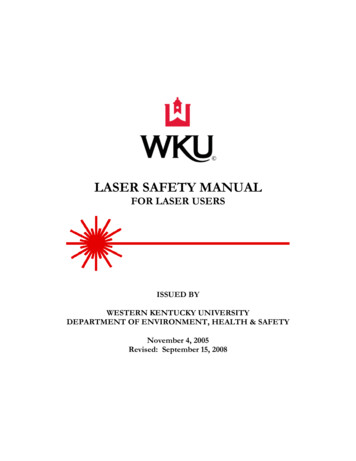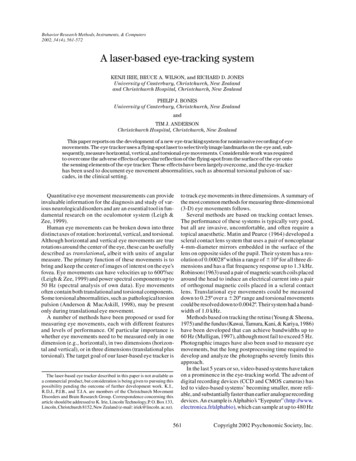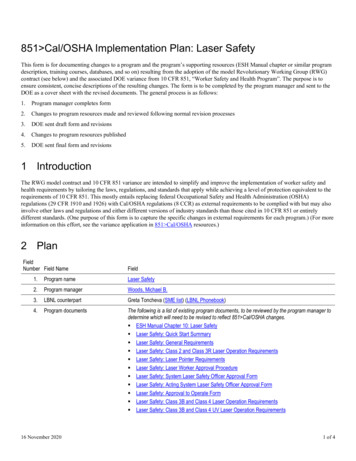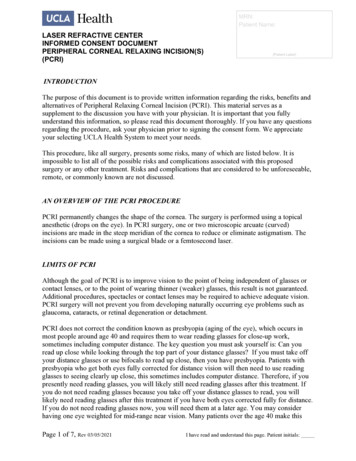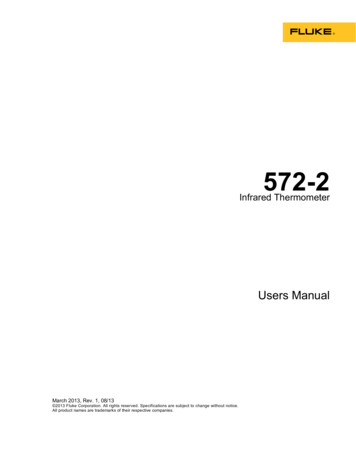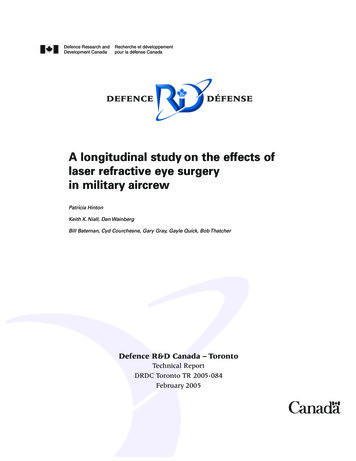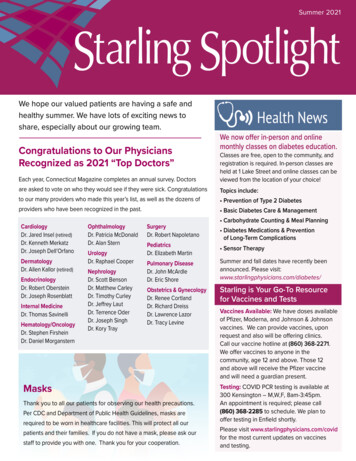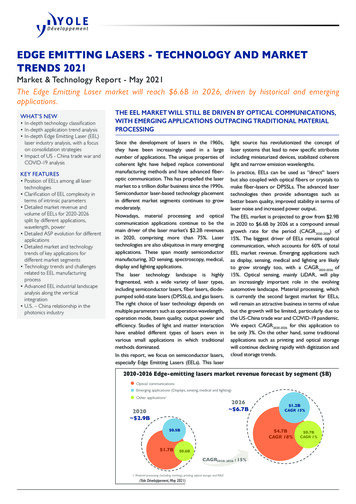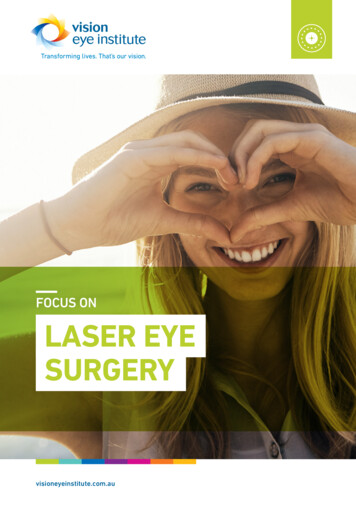
Transcription
FOCUS ONLASER EYESURGERYvisioneyeinstitute.com.au
CHOOSINGLASERMore thanA 20million peopleEYESURGEONaroundthe world have hadlaser eye surgery since it wasfirst introduced in 1991.1–3CONTENTSBASIC ELIGIBILITY CRITERIA3CHOOSING A LASER EYE SURGEON4THE PRE-SURGICAL CONSULTATION5WHAT TO EXPECT ON THE DAY OF SURGERY6RECOVERING AFTER SURGERY8YOUR QUESTIONS ANSWERED101. Alcon. Time for LASIK. United States, 2019. www.yourlasiksolution.com/about-lasik [Accessed 12 October 2020]. 2. ZEISS. SMILE: A brief guide. Germany,2020. -prevention/smile-laser-eye-surgery [Accessed 12 October 2020] 3. SCHWIND eye-tech-solutions.Press release: More than six million treatments with AMARIS. Germany, 2020. -million-amaris-treatments[Accessed 12 October 2020].2
BASIC ELIGIBILITYCRITERIAIf you use glasses and/or contact lenses,you’ve probably considered laser eyesurgery and wondered if you are eligible.At Vision Eye Institute we offer a range ofassessment options to help you find out ifyou’re eligible, including free, no-obligationinitial assessments with an optometristor orthoptist, virtual consultations andcomprehensive consultations.We also understand that some people preferto have an idea of their eligibility beforebooking an appointment. That’s why we’veput together a list of the basic eligibilitycriteria for laser eye surgery: You are between 18 and 55* years of age You suffer from long-sightedness,short-sightedness, astigmatism and/orpresbyopia Your eyes are healthy and you do not havea history of eye problems (e.g. scarring orthinning of the cornea) or significant eyetrauma Your glasses/contact lens prescriptionhas remained stable for 12 months You are not pregnant or breastfeedingIf you meet the above criteria, you may beeligible for laser eye surgery.CostAs a rough guide, laser eye surgerycan cost up to 3700 per eye. Whencomparing laser vision correction witha lifetime of glasses or contact lenses,you might be surprised to find out whichis the more cost-effective option.*Patients over 45 may still be eligible for lasereye surgery. However, we recommend bookinga comprehensive assessment to discuss othervision correction procedures that may bettersuit your needs.The next step is to book in for a free,no-obligation assessment with one of ourorthoptists or optometrists. Key tests will beperformed to check the health of your eyes,confirm that your prescription falls in thetreatable range and indicate which correctiveprocedure is appropriate for your situation.3
CHOOSING A LASEREYE SURGEONMany people find this a daunting task,especially how and where to begin.At this stage, remember to focus on thesuitability of the surgeon to perform theprocedure and important information aboutthe procedure itself (other questions aboutthe procedure, such as what to expect onthe day of surgery, can come later).The questions in the adjacent box will help yougather information about the qualificationsand experience of the surgeon and howwilling they are to discuss what is involvedand potential benefits and risks. You shouldalso gain an understanding of the facilities,equipment and sterile practices at the clinic.COMPARING COST IS DIFFICULT WHENIT COMES TO COMPLEX PROCEDURESLIKE EYE SURGERYCost is obviously a major factor for lasereye surgery. Always clarify whether the costis for one or both eyes and make sure youknow exactly what is included in the fee. It isimportant to make sure you are comparinglike with like, but this is often difficult when itcomes to complex procedures like eye surgery,where factors such as surgeon experience,success rate, equipment and access toaftercare are vital.It’s not possible to put a price on yourvision so make sure you do your homeworkthoroughly. Check if you’re unsure aboutsomething. Even though laser eye surgeryis very safe, all surgical procedures havepotential benefits and risks.You might find it helpful to bring a familymember or friend along to the appointmentand to take notes that you can refer backto afterwards.4Questions that you should askpotential surgeons/clinics: Are you registered with the RoyalAustralian and New Zealand Collegeof Ophthalmologists? How many laser eye surgeries haveyou performed and what is yoursuccess rate? Are there other treatment options andis this surgery the most appropriateoption for me? What is the optimal age for me to havelaser eye surgery? What are the potential complicationsfrom this surgery? Are there ways totreat these complications if they arise? If an enhancement is required, willthere be any extra cost? What type of lasers do you use andwhy? What type of anaesthesia do you use? What is the post-operative recoveryperiod? Is your facility fully accredited, doyou use sterile practices and are youadequately staffed? How much do you charge for laser eyesurgery and what exactly is includedin the fee? Does this include a postoperative review and after-hours carein case of emergencies? If I am concerned following thesurgery, how easy is it for me tocontact you?
THE PRE-SURGICALCONSULTATIONA comprehensive consultation is necessaryto determine if you are suitable for lasereye surgery and which procedure is mostappropriate for you. If you choose to have afree refractive suitability assessment, you willstill need to see a surgeon for a comprehensiveeye examination prior to surgery.Remember to let your surgeon/optometristknow of any eye-related health issues,together with more general health concernsor problems. Also specify what medications,if any, you take on a regular basis, as wellas medications you may be allergic to.During the pre-surgical assessment, you willundergo a comprehensive eye examinationso that your surgeon can evaluate your visionand establish whether you are suitable forlaser eye surgery. This includes severaleasy and painless tests such as vision andprescription testing; an eye pressure test; anda dilated eye exam, if required. Your surgeonwill then assess the health of your eyes andconfirm your degree of refractive error (i.e.the strength of your glasses prescription).LASIKLASIK is the most common type of lasereye surgery. It is suitable for patients withregular-shaped corneas and adequatecorneal thickness. LASIK can be used to treatshort-sightedness (myopia), long-sightedness(hyperopia) and astigmatism.PRKPRK (also known as ASLA) may be therecommended treatment if your corneasare irregular or too thin.SMILE SMILE* is an alternative procedure for patientswith regular-shaped corneas. It is particularlysuited to patients with a high degree of shortsightedness; individuals with a history ofocular surface conditions, such as dry eye;and athletes who play contact sports.*SMILE is only available in NSW.They will also evaluate the shape, contourand thickness of your cornea, and checkfor the presence of any irregularities. Thisinformation will be used to determine thelaser eye surgery procedure most appropriatefor your situation and the precise amountof corneal tissue that needs to be removedto bring your vision back to normal (or asclose as possible).During the consultation, the surgeon willadvise you of the benefits and risks of lasereye surgery and provide specific details aboutthe procedure that best suits your needs. Thisis also an opportunity for you to clarify yourvisual expectations and ask any questions youmay have about the procedure.SMILE is a registered trademark of Carl Zeiss Meditec5
WHAT TO EXPECT ONTHE DAY OF SURGERYWhat actually takes place on the day of yourprocedure?Before surgeryBefore coming to the clinic for your surgery,you need to follow our preparation guidelines.You can expect to be in the clinic for aroundtwo to three hours, and in the laser suite forapproximately 20 minutes. If you need lasereye surgery on both eyes, this will generallybe done on the same day.Prior to the surgery, anaesthetic eye dropswill be applied to numb your eyes. You will alsobe offered a mild oral sedative to help relaxyou before the procedure – this medicationis optional and you may decline if you do notwish to take it. After allowing a short timefor the sedative to work, you will be shownto the laser suite.6During surgeryBefore you enter the laser suite, the laser willhave been pre-programmed to correct yourrefractive error. Your surgeon will talk to youthroughout the process so you know whereto look and what to expect.Once you are lying flat on the bed, the laserwill be positioned so it is directly in line withthe eye being operated on. A small device(also known as a ‘speculum’ or ‘lid holder’)will be fitted to your eye to hold your lids openand stop you from blinking. The laser hasan infrared eye-tracker that measures andcompensates for any eye movement duringthe procedure.Your surgeon will let you know when theprocedure is about to start.
LASIKLASIK is a two-step vision correctionprocedure. In the first step, the surgeoncreates a flap in the top layer of the cornea,exposing the tissue bed underneath – youmay feel slight pressure during this stage.In the second step, an excimer laser is used toreshape the cornea. As the laser moves acrossthe cornea, you may feel a slight sensationbut no pain. Once reshaping is complete, thesurgeon gently replaces the corneal flap andthe healing process begins immediately.Following the laser procedure for the firsteye, the lid holder will be removed and theprocedure repeated on your second eye(if required).Ultimately, all three techniques achieve thesame result – that is, restoring your visionby correcting your specific refractive error.PRKDuring PRK, the surgeon will gently removethe top layer of corneal cells. This may bedone using a brush, alcohol solution, or withthe laser (this is known as ‘transPRK’). Anexcimer laser is then used to reshape thecorneal tissue. During the laser step, you mayfeel a slight sensation but no pain. Afterwards,a ‘bandage’ contact lens is placed on top of theeye to aid the healing processSMILESMILE involves using one laser to prepareand reshape the cornea. The surgeon uses afemtosecond laser to create a 3 mm keyholeentry point. Next, the laser creates a preciselens-shaped disc of tissue within the cornea.This disc of tissue (called a lenticule) is thenremoved through the keyhole incision. Duringthe procedure, you may feel some pressureor mild discomfort but no pain.After surgeryOnce the laser procedure is complete, you willbe helped off the bed and led into the recoveryroom. You may be able to see distant objects,but your vision will be blurry – this is normal.Depending on the procedure, you may need toremain in the recovery room for around halfan hour to allow your eyes to adjust and theeffects of the sedative to wear off (if taken).When it is time to be discharged, you will needa friend or relative to accompany you. You willnot be able to drive yourself home as yourvision will be slightly blurry for several hoursafter surgery. Once home, it is important thatyou rest for the remainder of the day.7
RECOVERINGAFTER SURGERYThe recovery period is different for LASIK,PRK and SMILE.How fast your eyes recover after surgerydepends on the type of laser visioncorrection procedure you have had. You willbe discharged with eye drops (artificial tears,anti-inflammatory drops and antibiotic drops)and medication to help your recovery, alongwith goggles or eye shields to prevent you fromaccidentally touching your eyes while you sleep.Your surgeon will tell you how long you shouldcontinue to use your eye drops for. You canexpect to use them for approximately three tofour weeks.Though recovery is very quick, it’s normal toexperience some symptoms that may causeminor discomfort after LASIK. The procedurecan reduce tear production, so your eyes mayfeel dry and/or gritty during the recoveryperiod. The eye drops you are discharged withwill relieve these symptoms. In the days andweeks after surgery, you may also experiencefluctuating vision and see halos around lights,which should eventually pass. Some peoplealso experience light sensitivity for up to aweek – wearing sunglasses can help. Overall,for most patients, the recovery from LASIKis very fast with little or no discomfort.LASIKLASIK has the fastest recovery period and mostpatients notice significant visual improvementwithin a day. This is because the proceduredoesn’t disturb the top layer of the cornea,rather a flap is folded back and the layersbeneath are lasered. Once the flap is replaced,vision stabilises quickly.Your first review appointment will take placelater the same day, or the next day. During thisappointment, we will check you are recoveringwell from your surgery. You should allow oneor two days for your vision to settle. Once youreyes are comfortable, you can visit the relevantlicensing centre (e.g. Service NSW, VicRoads,TMR) to re-sit the visual exam and update theconditions of your driver’s license.You’ll be able to resume most activities theday after surgery. However, you must waittwo weeks before swimming and a monthbefore playing contact sports. You shouldavoid rubbing your eyes and wearing eyemakeup for one week.PRKThe recovery from PRK is slower and moreuncomfortable than the other proceduresbecause your cornea needs to grow a newlayer of cells. Your eyes are likely to be veryuncomfortable and sensitive for the first fewdays after surgery, but this will gradually subsideas the cornea heals. A bandage contact lens isworn to protect the cornea during healing andyou’ll be given non-steroidal anti-inflammatorydrops and oral pain relief medication to helpmanage the discomfort.You will have a post-operative consultationwithin 1–5 days after surgery to remove the8
bandage contact lens. Your eye will feela lot better after the bandage contact lensis removed, but you may still experiencesome discomfort for up to a week.It is also normal to experience dry eyeduring the first two to three weeks after PRK.Artificial tear drops will alleviate symptomsand help your eyes recover.After PRK, vision can take a week or twoto become functional enough for everydayactivities. You may feel able to restartsome visual activities the day after surgery.However, most people find it uncomfortable,so it’s advisable to plan for some activitiesthat allow you to rest your eyes (e.g. podcasts,audiobooks) for the first few days. It generallytakes around a week to return to activitiessuch as work, wearing eye makeup, exerciseand swimming. You must avoid playing contactsports for 2–4 weeks. Your doctor will tellyou when it is safe to drive, which is normallywithin one to two weeks.Though it takes longer to recover after PRK,patients have great visual outcomes oncevision stabilises.SMILEAfter SMILE, the surfaces of the cornealflap and the underlying cornea need to heal,so it typically takes two or three days foryour eyes to recover and reach clear vision.You will need to visit your surgeon for a postoperative consultation either later the sameday or the next day. You should allow one ortwo days for your vision to settle. Once youreyes are comfortable, you can visit ServiceNSW to re-sit the visual exam and update theconditions of your driver’s license.The recovery after SMILE is painless. SMILEcauses less disturbance to the cornealnerves than LASIK and PRK, so it is lesslikely that patients will experience dry eyeor gritty sensations after surgery. Somelight sensitivity and fluctuating vision isnormal and will resolve within a few weeks.After SMILE, you can returnto everyday activities, such aslight exercise, household choresand using a computer, within a few days aftersurgery. Some tasks that require critical vision(e.g. reading fine print, driving at night) may bedifficult during the first few days. On day fiveafter surgery, all activities can be resumed.This includes getting water in your eyes,swimming, physical activities, contact sports,wearing eye makeup and using eye creams.Indeed, many people choose SMILE becauseof the quick return to contact sports.While visual recovery after SMILE takesslightly longer than LASIK, it is still fastand this procedure gives you the freedomto resume sports and all other activitiesonly five days after the procedure.Follow-up consultationsFurther check-ups will be scheduled in themonths following your surgery to keep trackof your recovery and monitor your visiononce it has stabilised. In a small number ofpatients, a second (enhancement) proceduremay be recommended to further improvevision. If required, this is usually performedapproximately six months after the initialprocedure.Enjoy your new eyesAfter the different recovery periods, theoutcomes from LASIK, PRK and SMILE arethe same. Most people have normal visionafter laser eye surgery and are very happywith their result.Remember to be patient over the days andweeks following your procedure. Continueto use the eye drops and medications asdirected to help your eyes recover as quicklyas possible. Always check with your surgeonif you are unsure about when you can resumea particular activity after surgery.Once you are enjoying life free from glassesor contact lenses, the initial recovery periodwill seem like a distant memory.9
YOUR QUESTIONSANSWEREDIs laser eye surgery permanent?LASIK, PRK and SMILE permanently reshapethe cornea. Some people may require a followup procedure to enhance or improve the initialresults.It’s important to be aware that presbyopiacan develop at around 40–50 years of age.Presbyopia is an age-related condition ofyour lens, which reduces your ability to focuson near objects and will occur regardless ofwhether you have laser eye surgery or not.Presbyopia does not involve the cornea. Lasereye surgery will not prevent the developmentof presbyopia, although it is sometimes usedto delay the need for glasses.What if I am pregnant, breastfeedingor trying to conceive?Laser eye surgery is avoided in womenwho are pregnant. Many women experiencefluctuating vision during pregnancy. Thisoccurs when hormonal changes cause yourbody to retain fluid, which can cause thecornea to swell. Some women may be moreshort-sighted while they are pregnant. Werecommend waiting until your vision returnsto its previous state, generally within a fewmonths after giving birth. Additionally, themedications used during and after surgerycould affect your unborn baby.If you are breastfeeding and wish to havelaser eye surgery, you will need to discuss thisdirectly with your surgeon. This will depend onvarious factors, including the age of your baby.You should also wait at least three weeksafter having laser eye surgery before tryingto conceive. There is a small chance that themedications could be absorbed into yourbloodstream.10Does laser eye surgery hurt?Laser eye surgery isn’t painful. Most peoplereport feeling mild pressure on theireye. However, all patients are given localanaesthetic drops and often a mild sedative.How long does the procedure take?You will be in the clinic for around 2–3 hours,but the surgery itself only takes about 20minutes for both eyes.How quickly does laser eye surgerywork?Many people are surprised that they can seedistant objects, such as a clock on the wall,as they are leaving the laser suite. Most peoplecan legally drive without the use of glassesor contact lenses one to two days after havingLASIK or SMILE.PRK ultimately provides the same visualoutcome as LASIK and SMILE, althoughrecovery time is longer. Your vision canfluctuate for up to six weeks before it settles.
What happens if I blink?You don’t need to worry about blinking duringlaser eye surgery. During the procedure, asmall device (also known as a ‘speculum’ or‘lid holder’) will be fitted to your eye to holdyour lids open and stop you from blinking.The laser is highly sophisticated and fittedwith an infrared eye tracker. This trackerconstantly measures your eye movementsduring surgery. Even the smallest movementwill be detected, which the laser willcompensate for.How long do I have to wait beforeplaying sport or swimming?Good visual function is achieved within 24–48hours with LASIK and SMILE but may take upto two weeks with PRK.If surgery was routine and successful, contactsports (including martial art sparring) can beresumed within five days after SMILE, 2–4weeks after PRK and one month after LASIK.Swimming may be resumed five days afterSMILE, one week after PRK and two weeksafter LASIK.What are the side-effects of laser eyesurgery?Laser eye surgery is a routine procedure.However, like any surgical procedure, thereare always potential benefits and risks.Minor side-effects are seen in around 1–2%of patients. For example, a less-than-expectedvisual result that requires an enhancementor temporary dry eyes that require drops.Very rarely, some patients can get infections orsuffer complications that are more serious. Thechance of having a serious vision-threateningcomplication is extremely small (very muchless than 1%). No patient in Australia has everbecome blind from laser eye surgery.Selecting the correct procedure for youreyes (which sometimes means not havingsurgery at all) minimises the risk of a seriouscomplication. The experience of your surgeonand the clinic staff are also very importantconsiderations.Vision Eye Institute surgeons and clinicsadhere to strict sterility and surgicalprocesses and have access to the lateststate-of-the-art equipment and technology.Patients are discharged with the appropriatepost-operative medication, which may includeantibiotic drops and pain-relief medication.Always have a comprehensive discussionabout the benefits and risks of surgery withyour ophthalmologist before proceeding.Will Medicare or my private healthfund cover any of the cost?Please note that Medicare does not rebate anyof the cost of laser eye surgery (apart from thecost of the pre-surgical consultation). Someprivate health insurers provide cover for lasereye surgery in some of their products. Medibankmembers with selected extras and packagedcovers can receive 15% off surgical fees atVision Eye Institute (excludes consultation fees).A fund check may be performed to assess youreligibility. Check with your health insurer if yourlevel of cover includes rebates for laser eyesurgery.What if I’m not suitable for laser eyesurgery?There are several reasons why laser eyesurgery may not be suitable for somepeople. Depending on the reason, othervision correction options may be suitable.Examples include replacement lensexchange or implantable lenses. Once youhave had your eyes tested and examined,your ophthalmologist will be able to discussalternative treatment options with you.11
CONTACT USIf you would like to know more about whether laser eye surgerycould be right for you, contact one of our laser clinics to:1. Book a free, no-obligationassessment with an optometristor orthoptistTo check the health of your cornea anddetermine if you are within the treatablerange. You may then choose to follow upwith a full consultation.Virtual laser assessments are also available.Call 1800 1 LASER to learn more.2. Book a consultation with asurgeon or clinical optometrist*To undergo comprehensive eye testing andexamination to confirm your eligibility forlaser eye surgery and which procedure isrecommended for you.There is no obligation to proceed with surgery.*Surgical consultations attract a fee – a Medicare rebateis available with a referral letter from a GP or optometrist.Please note that surgery cannot proceed without a surgical consultation first.NEW SOUTH WALESBONDI JUNCTIONCHATSWOODHURSTVILLET: 02 9386 3666T: 02 9424 9999T: 02 9330 6900VICTORIAQUEENSLANDBRISBANE (Dr Lenton)TOWNSVILLEMELBOURNE (ST KILDA RD)T: 07 3736 3015T: 07 4728 9634T: 03 9521 2175visioneyeinstitute.com.auVEI Services Pty Ltd ABN 94 097 821 906VEI29326 GEN-VEI-FOCUS-LES 06-21
laser eye surgery since it was first introduced in 1991.1-3 CONTENTS BASIC ELIGIBILITY CRITERIA 3 CHOOSING A LASER EYE SURGEON 4 THE PRE-SURGICAL CONSULTATION 5 WHAT TO EXPECT ON THE DAY OF SURGERY 6 RECOVERING AFTER SURGERY 8 YOUR QUESTIONS ANSWERED 10 1. Alcon. Time for LASIK.

